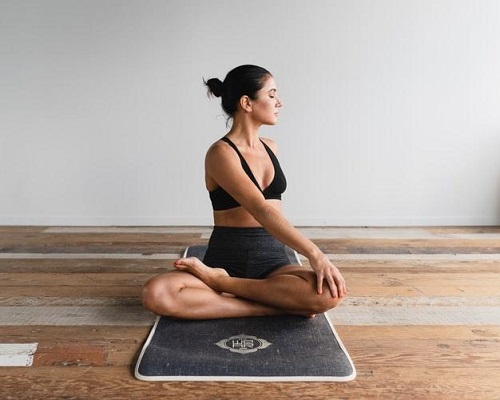If you suffer from an aching back, you are not alone. In fact, 8 out of 10 people experience some form of chronic pain ranging from mild to severe throughout their lives.
Whether you blame poor posture, lack of physical conditioning, or good ol' genetics, finding the root cause will help you seek healing relief.
Sometimes you must make a change in your behaviour (i.e. stop carrying that heavy bag, don't slouch OR sit up TOO straight).
Other times, as in the case of spondylolisthesis or sciatica when nerve or spinal cord damage is present, you need medical advice because the "wrong" type of activity (or inactivity) can indeed contribute to making the situation worse.
However, when back pain strikes, mindful yoga has been proven to alleviate symptoms for a significant amount of time, even for weeks following the practice. Flow with these following yoga poses to ease back pain either in sequence, or by incorporating them as you see fit into your daily routine.
1. Reclining Hand-to-Big-Toe Pose (Supta Padangusthasana)

This multi-tasking asana increases your hip and hamstring flexibility, improves overall circulation, and takes the load off the lumbar spine. If reaching for the toe feels like an impossible task, loop a strap on the ball of your foot, grabbing each end with both hands for extra support.
Do not hesitate to bend the knee if you feel any excessive pulling or strain in the neck or back. Remember, you do not have to contort yourself to execute the posture.
2. Posture of Marichi B (Marichyasana B or Marichyasana II)

To keep your back happy here, you MUST create length as you twist. All too often, settling too deep into a rounded lower back can exacerbate pain and injury.
Make sure to support yourself with one hand and maintain stability in the hips, which will allow you to rotate from the thoracolumbar spine (mid-back), utilize the core, and maximize chest expansion.
3. Supported Seated Forward Bend (Supported Paschimottanasana)

Even if you feel completely unhindered in your hamstrings, try sitting on a block or a blanket in Paschimottanasana.
This variation allows the pelvis to establish an anterior tilt that will free up tension in the lower back, enhance the natural s-curve of the spine, and provide greater outer shoulder stretch rather than just an excessive hunched upper back which is a common mistake practiced too often in this pose.
4. Wide-Legged Forward Bend (Prasarita Padottansana D)

Have you heard of “The Back and Bicep Rule?†When you pull yourself deeper into this pose with your biceps, you help activate your back muscles, specifically your latissimus dorsi which falls into the “core†category.
Stay mindful of sliding the shoulder blades towards the hips to keep your shoulders from crowding your neck. This inversion will relax your back, stretch the hamstrings, and improve your balance.
5. Supported Bridge Pose (Supported Setu Bandha Sarvangasana)
Depending on where your back pain tends to accumulate, you can use blocks or bolsters to create a blissfully healing setup that uniquely suits you. Try one or both of these variations.
For Pain in the Cervical/ Upper Back:

Place one block horizontally beneath the shoulder blades and one block underneath the head to undo the effects of sitting at a desk hunched over a computer all day.
For Pain in the Lumbar/ Lower Back:

Place one block beneath your sacrum and one under the lumbar spine so you can fully rest your body weight. Start with the blocks at medium height and gradually increase the height as you feel your spine lengthening.
6. Supported Child's Pose (Salamba Balasana)

Resting on a bolster between the legs during Child’s Pose will prevent you from “overdoing†the stretching and offers gentle support to restore the spine.
All too often throughout the day, we move from sitting to standing with nothing in between. This pose teaches you to walk the middle path and provides you with healing “active†rest.
7. Legs-Up-the-Wall Pose (Viparita Karani)

This elevated pose promotes overall relaxation and specifically assists in releasing tension from the muscles that travel up and down the length of the spine.
Practice caution when getting in and out of the pose, however. Make sure that you have ample room to your right and left so you can pause on one side and use your arms instead of yanking yourself up with your neck when you are ready to transition to your next pose or back to standing.
For yoga to have long term benefits, consistency is key. Yoga will keep you aware of your posture and your habits both on and off the mat.
Often times, strengthening the core will help keep back pain symptoms at bay; however, if you seek to ease suffering, refrain from exerting yourself until the pain subsides. Seek the balance between strength and flexibility, and pretty soon your back pain will be a thing of the past.
credit: doyou.com





